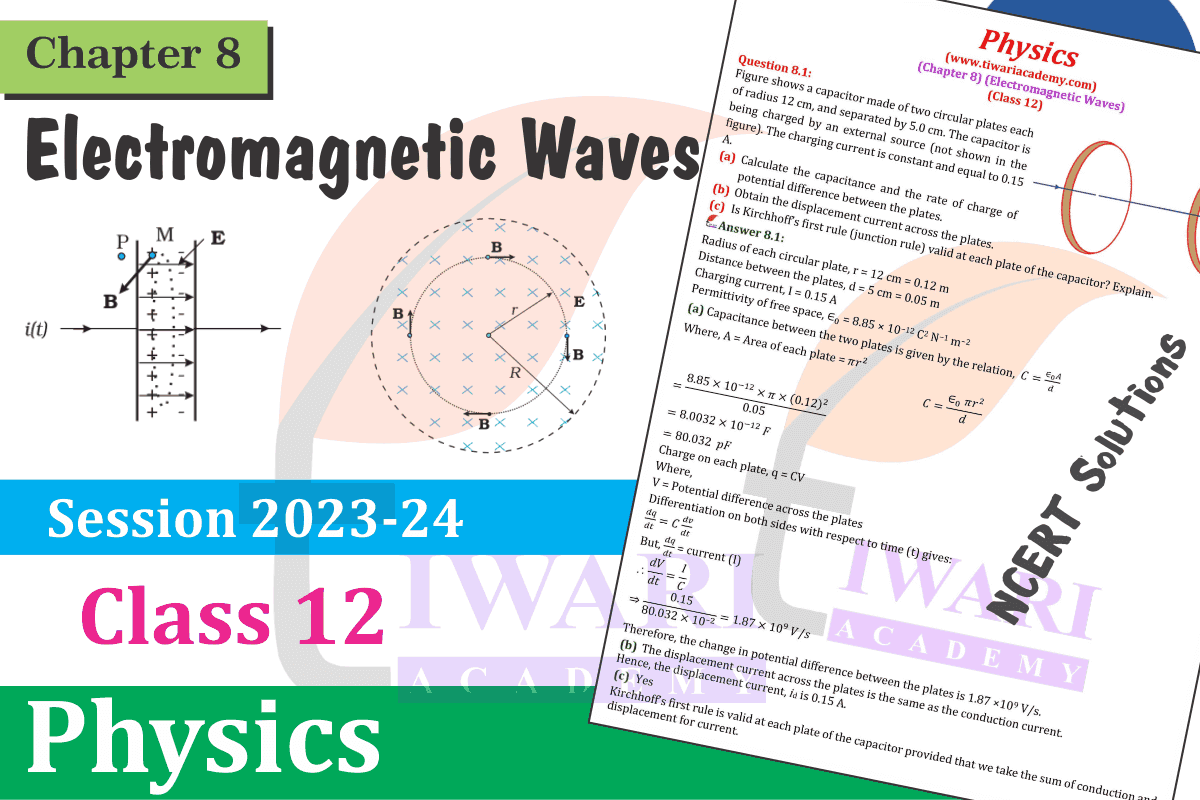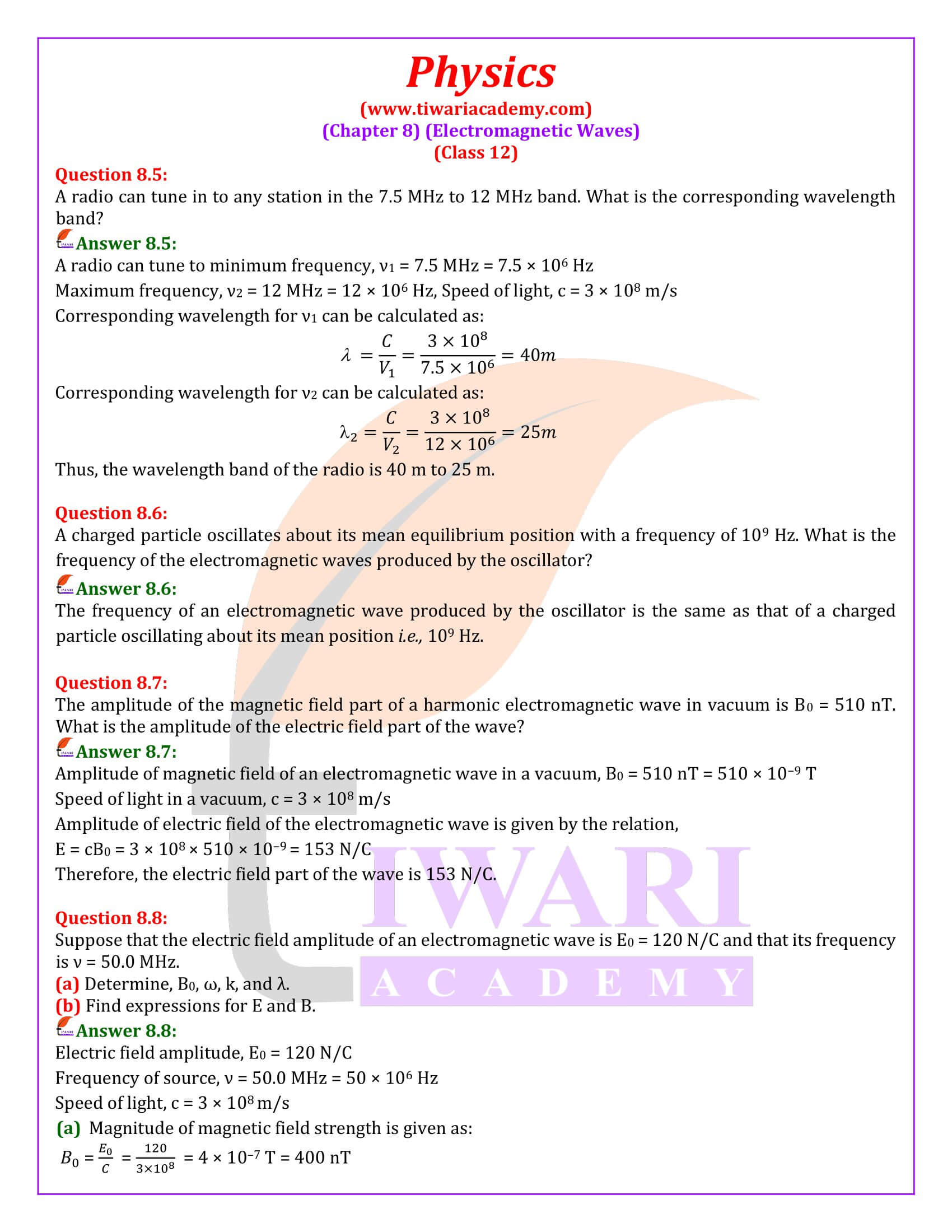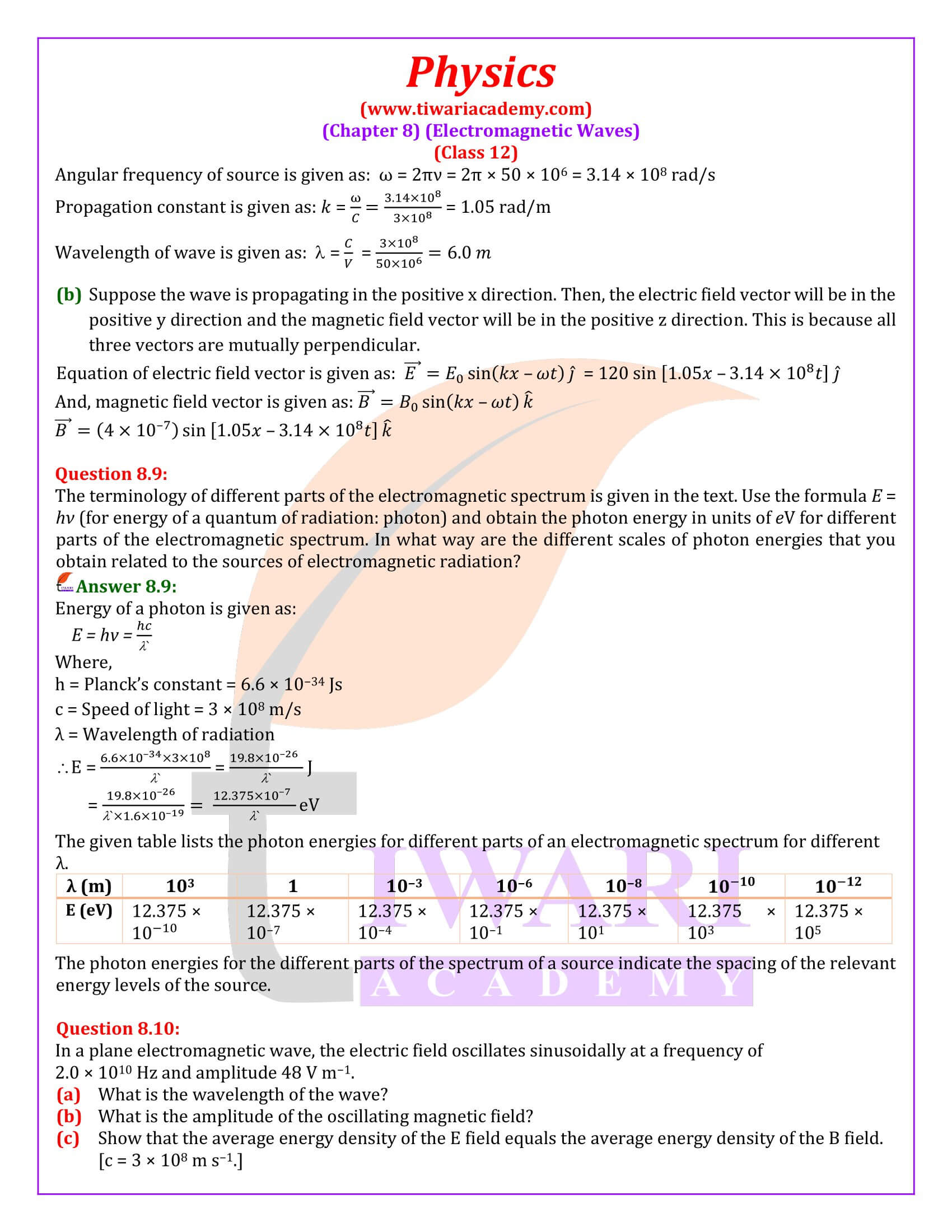NCERT Solutions for Class 12 Physics Chapter 8 Electromagnetic Waves (EM Waves) in English and Hindi Medium updated for session 2025-26. As per new syllabus and NCERT books for 2025-26, the additional exercise in chapter 8 class 12 Physics is not in syllabus.
Viva Questions for Class 12 Physics
How to Prepare for Class 12 Physics Board Exam
Study Plan for Class 12 CBSE Board 2025
NCERT Solutions for Class 12 Physics Chapter 8
Chapter 8 Electromagnetic Waves Solutions
- Class 12 Physics Chapter 8 Exercises Solutions
- 12th Physics Chapter 8 Additional Exercises (Not in Syllabus)
- Class 12 Physics Chapter 8 Solutions in Hindi
- Class 12 Physics NCERT Book Chapter 8
- Class 12 Physics Revision Book Chapter 8
- Revision Book Answers
- Class 12 Physics Chapter 8 Revision Notes 1
- Class 12 Physics Chapter 8 Revision Notes 2
- Visit to 12th Physics Main Page

Exercises Solutions and Additional Exercises Solutions in PDF form as well as study online mode for session 2025-26. Download UP Board Solutions and CBSE Offline Apps and NCERT Solutions are based on updated NCERT Books for 2025-26 session.
| Class: 12 | Physics |
| Chapter 8: | Electromagnetic Waves |
| Content: | Exercises and Additional Questions |
| Mode of Content: | Videos, Images and Text |
| Session: | Academic Year 2025-26 |
| Medium: | Hindi and English |
Class 12 Physics Chapter 8 Solutions in English
NCERT Solutions for Class 12 Physics Chapter 8 EM Waves in PDF form free download. Download Offline Apps and NCERT Books 2025-26 based on latest CBSE Syllabus. If you have any doubt regarding to NIOS Board or CBSE Board or any other education suggestion, please visit to discussion forum to interact with us.

Important Questions for practice
1. A water tank is 4 meter deep. A candle flame is kept 6 meter above the level. n for water is 4/3. Where will the image of the candle be formed? [Answer: 6 m. below the water level.]
2. State the principles of production of EM waves. An EM wave of wavelength λ goes from vacuum to a medium of refractive index n. What will be the frequency of wave in the medium?
3. The image of a small bulb fixed on the wall of a room is to be obtained on the opposite wall ‘s’ m away by means of a large convex lens. What is the maximum possible local length of the lens required.
4. Name EM radiations used (i) in the treatment of cancer. (ii) For detecting flaw in pipes carrying oil.
(iii) In sterilizing surgical instruments.
5. Find the wavelength of electromagnetic waves of frequency 5 x 10^19 Hz in free space. Give its two applications.
Questions from Board Papers
1. The amplitude of the magnetic field vector of an electromagnetic wave travelling in vacuum is 2.4mT. Frequency of the wave is 16 MHz. Find: (i) Amplitude of electric field vector and (ii) Wavelength of the wave.
2. Relative electric permittivity of a medium is q and relative permeability is close to unity. What is the speed of em waves in the medium.
3. Name the part of the electromagnetic spectrum of wavelength 10^-2 m and mention its one application.
[Answer: Microwave, microwave oven.]
4. Which physical quantity, If any has the same value for waves belonging to the different parts of the electromagnetic spectrum?[Answer: Speed]
5. For the same angle of the incidence the angle of refraction in three media A, B and C are 15°, 25° and 35° respectively. In which medium would the velocity of light be minimum? [Answer: A]
Important Questions on 12th Physics Chapter 8
What physical quantity is the same for X-rays of wavelength 10^−10 m, red light of wavelength 6800 Å and radio waves of wavelength 500 m?
The speed of light (3 × 108 m/s) in a vacuum is the same for all wavelengths. It is independent of the wavelength in the vacuum.
A charged particle oscillates about its mean equilibrium position with a frequency of 109 Hz. What is the frequency of the electromagnetic waves produced by the oscillator?
The frequency of an electromagnetic wave produced by the oscillator is the same as that of a charged particle oscillating about its mean position i.e., 109 Hz.
The amplitude of the magnetic field part of a harmonic electromagnetic wave in vacuum is B₀ = 510 nT. What is the amplitude of the electric field part of the wave?
Amplitude of magnetic field of an electromagnetic wave in a vacuum, B₀ = 510 nT = 510 × 10⁻⁹ T Speed of light in a vacuum, c = 3 × 10⁸ m/s Amplitude of electric field of the electromagnetic wave is given by the relation, E = cB₀ = 3 × 10⁸ × 510 × 10⁻⁹ = 153 N/C Therefore, the electric field part of the wave is 153 N/C.
Suppose that the electric field part of an electromagnetic wave in vacuum is E = {(3.1 N/C)cos [(1.8 rad/m) y + (5.4 × 10⁶ rad/s)t]} i. What is the direction of propagation?
From the given electric field vector, it can be inferred that the electric field is directed along the negative x direction. Hence, the direction of motion is along the negative y direction i.e. -j ̂.
State the part of the electromagnetic spectrum to which each belongs 21 cm (wavelength emitted by atomic hydrogen in interstellar space).
Radio waves; it belongs to the short wavelength end of the electromagnetic spectrum.
Long distance radio broadcasts use short-wave bands. Why?
Long distance radio broadcasts use shortwave bands because only these bands can be refracted by the ionosphere.
It is necessary to use satellites for long distance TV transmission. Why?
It is necessary to use satellites for long distance TV transmissions because television signals are of high frequencies and high energies. Thus, these signals are not reflected by the ionosphere. Hence, satellites are helpful in reflecting TV signals. Also, they help in long distance TV transmissions.
Optical and radio telescopes are built on the ground but X-ray astronomy is possible only from satellites orbiting the earth. Why?
With reference to X-ray astronomy, X-rays are absorbed by the atmosphere. However, visible and radio waves can penetrate it. Hence, optical and radio telescopes are built on the ground, while X-ray astronomy is possible only with the help of satellites orbiting the Earth. (d) The small ozone layer on the top of the atmosphere is crucial for human survival because it absorbs harmful ultraviolet radiations present in sunlight and prevents it from reaching the Earth’s surface.
The small ozone layer on top of the stratosphere is crucial for human survival. Why? (e) If the earth did not have an atmosphere, would its average surface temperature be higher or lower than what it is now?
In the absence of an atmosphere, there would be no greenhouse effect on the surface of the Earth. As a result, the temperature of the Earth would decrease rapidly, making it chilly and difficult for human survival.
Some scientists have predicted that a global nuclear war on the earth would be followed by a severe ‘nuclear winter’ with a devastating effect on life on earth. What might be the basis of this prediction?
A global nuclear war on the surface of the Earth would have disastrous consequences. Post-nuclear war, the Earth will experience severe winter as the war will produce clouds of smoke that would cover maximum parts of the sky, thereby preventing solar light form reaching the atmosphere. Also, it will lead to the depletion of the ozone layer.









